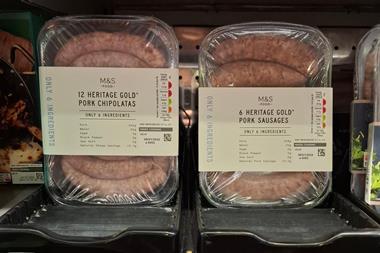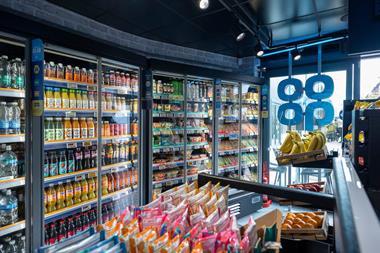With the European Council at odds with the EU Parliament on standardised nutrition labelling, what is the current outlook for the UK, asks Nick Hughes
Snails have been known to move more quickly than the EU debate on standardised nutrition labelling.
Agreement appears more remote than ever after the European Council this week published draft proposals for food labelling that are at odds with those of MEPs.
"Disappointing and sloppy," is how Renate Sommer, the German MEP who drafted the European Parliament's opinion in June, describes the council's proposal. The document ignores important details and waters down key aspects of the parliament's recommendations, she claims, and agreement between the two sides will now be a "distant" prospect when the proposals get their Second Reading in parliament next year.
Harmonising EU food labelling laws was never going to be straightforward, given the divergent interests of industry, consumer groups and health organisations. But for the European Council and Parliament to be so discordant at this stage presents a real threat to the establishment of a consistent labelling scheme. So what are the dividing lines between the two sides and what impact will the latest proposals have in Britain?
"While it's true that the EU Council of Ministers has reached agreement on new food labelling laws, the controversy surrounding the topic is far from over," warns Owen Warnock, partner at law firm Eversheds. "The European Parliament wants much more extensive disclosure on labels, giving comprehensive details of nutrients and stating country-of-origin information for many products."
One of the biggest bones of contention has been nutrition declarations. The decisive, if not universally popular, proposals by parliament for compulsory front-of-pack labelling for fat, saturates, sugar, salt and energy per 100g or 100ml have been torn up by the council, which argues that nutrition information should be displayable anywhere on pack so long as it all appears in the "same field of vision".
If the council's proposals are adopted, the UK status quo would barely change. The decision by parliament to forbid national schemes running parallel to an EU-wide scheme would be reversed by the council, which states food operators can use additional forms of presentation as long as "they do not mislead the average consumer". In practice, this means every scheme currently in operation by UK retailers and producers, from Sainsbury's multiple traffic-light labelling to Nestlé's GDA per portion label, could continue to be displayed as before.
However, minimum font size is also on the agenda, with the council recommending that text on packaged food with a surface area greater than 60 sq cm should be at least 1.2mm high. The FDF argues that a mandatory minimum font is impractical and would cost millions to implement. 'Best-before' dates could also become obsolete after the council proposed the compulsory labelling of use-by dates for perishable foods.
Where parliament and council are in broad agreement is on country-of-origin labelling, with the council proposing immediate compulsory origin labelling of all meat, although it stops short of extending the requirement to dairy for a period of at least three years. Last month, Defra drew up an industry-wide code that pre-empted the council's stance on country-of-origin labelling. "Today's political agreement is a big step in the right direction," says Meurig Raymond, deputy president of the NFU, which lobbied hard for clearer EU guidelines on country of origin.
The issue of country-of-origin labelling may be closer to resolution, but wider agreement is still a long way off. "It's crucial that all involved in the food industry keep very close tabs on these debates, since the outcome could not only have a major impact on the labelling and presentation of food and drinks, but could potentially lead to extensive reformulation of recipes as well," says Warnock. "We can expect to see at least another six months of wrangling."
Council proposals
- Forget front-of-pack labelling. Content of fat, saturates, carbohydrates, protein, sugars and salt per 100g or 100ml only need be in "same field of vision"
- Information to be printed in a minimum font size of 1.2mm
- Alcoholic drinks, with the exception of alcopops, to be exempt from providing nutritional information
- Compulsory country-of-origin labelling of meat, with possible extension to dairy in three years
Snails have been known to move more quickly than the EU debate on standardised nutrition labelling.
Agreement appears more remote than ever after the European Council this week published draft proposals for food labelling that are at odds with those of MEPs.
"Disappointing and sloppy," is how Renate Sommer, the German MEP who drafted the European Parliament's opinion in June, describes the council's proposal. The document ignores important details and waters down key aspects of the parliament's recommendations, she claims, and agreement between the two sides will now be a "distant" prospect when the proposals get their Second Reading in parliament next year.
Harmonising EU food labelling laws was never going to be straightforward, given the divergent interests of industry, consumer groups and health organisations. But for the European Council and Parliament to be so discordant at this stage presents a real threat to the establishment of a consistent labelling scheme. So what are the dividing lines between the two sides and what impact will the latest proposals have in Britain?
"While it's true that the EU Council of Ministers has reached agreement on new food labelling laws, the controversy surrounding the topic is far from over," warns Owen Warnock, partner at law firm Eversheds. "The European Parliament wants much more extensive disclosure on labels, giving comprehensive details of nutrients and stating country-of-origin information for many products."
One of the biggest bones of contention has been nutrition declarations. The decisive, if not universally popular, proposals by parliament for compulsory front-of-pack labelling for fat, saturates, sugar, salt and energy per 100g or 100ml have been torn up by the council, which argues that nutrition information should be displayable anywhere on pack so long as it all appears in the "same field of vision".
If the council's proposals are adopted, the UK status quo would barely change. The decision by parliament to forbid national schemes running parallel to an EU-wide scheme would be reversed by the council, which states food operators can use additional forms of presentation as long as "they do not mislead the average consumer". In practice, this means every scheme currently in operation by UK retailers and producers, from Sainsbury's multiple traffic-light labelling to Nestlé's GDA per portion label, could continue to be displayed as before.
However, minimum font size is also on the agenda, with the council recommending that text on packaged food with a surface area greater than 60 sq cm should be at least 1.2mm high. The FDF argues that a mandatory minimum font is impractical and would cost millions to implement. 'Best-before' dates could also become obsolete after the council proposed the compulsory labelling of use-by dates for perishable foods.
Where parliament and council are in broad agreement is on country-of-origin labelling, with the council proposing immediate compulsory origin labelling of all meat, although it stops short of extending the requirement to dairy for a period of at least three years. Last month, Defra drew up an industry-wide code that pre-empted the council's stance on country-of-origin labelling. "Today's political agreement is a big step in the right direction," says Meurig Raymond, deputy president of the NFU, which lobbied hard for clearer EU guidelines on country of origin.
The issue of country-of-origin labelling may be closer to resolution, but wider agreement is still a long way off. "It's crucial that all involved in the food industry keep very close tabs on these debates, since the outcome could not only have a major impact on the labelling and presentation of food and drinks, but could potentially lead to extensive reformulation of recipes as well," says Warnock. "We can expect to see at least another six months of wrangling."
Council proposals
- Forget front-of-pack labelling. Content of fat, saturates, carbohydrates, protein, sugars and salt per 100g or 100ml only need be in "same field of vision"
- Information to be printed in a minimum font size of 1.2mm
- Alcoholic drinks, with the exception of alcopops, to be exempt from providing nutritional information
- Compulsory country-of-origin labelling of meat, with possible extension to dairy in three years













No comments yet